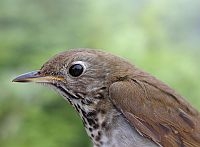
Red-wing blackbirds, robins, yellow-throats and
phoebes. The return of our region’s
birds is one of the most reliable signs of spring. We talk with Audubon Bird Expert Bridget
Butler about which species have already returned, and which birds we can soon expect to see. (Listen)
Also, 140 Vermonters are traveling to New
York to meet and attend mass with Pope Benedict
XVI. We talk with Father John McDermott
from the Roman Catholic Diocese in Burlington
about the Pope’s visit. (Listen)
And, we continue our series of audio postcards from Vermont
towns with a trip to the ghost town of Glastenbury. (Listen)
More birding Q & A:
Doreen from Ringe,
NH:
 I heard the show on birds and have
I heard the show on birds and have
a question about a bird that graced our property 2 years ago. We’ve been trying
to find out what it is, some say it is an AUK and others say it is a Muscovy
but there are attributes that don’t fit that profile. It has a duck bill, feet
and similar body shape albeit a little thinner, and walked upright. It is brown
and white. I heard you say that ducks will cross with other breeds so I wonder
if this is one example of that or if this is some breed of duck that we can’t
find in our bird book or online.
Bridget Butler’s response:
Wow Doreen, you’ve got a perfect
example here of some weird-waterfowl! [Bridget checked with fellow bird geeks
and offers this identification:] Indian Runner Mallard ducks. They were brought to the States and Europe
from the Indies because of their egg-laying ability.
Apparently give chickens a run for their money in terms of laying! Very cool!
Dean from N. Wolcott:
First, I have a broken leg on the mend right now so, here’s
the story. My wife was kind enough to put out our Oriole feeder out last
week. My 13 year-old son excitedly hollered to me the other morning when he saw
2 Orioles near the feeder. I grabbed my crutches and hobbled to the
nearest window and opened the curtains a bit spastically and scared the Orioles
away. I didn’t really see them. [Dean has these questions:] 1) When do they like to feed? 2) How long is their season? 3) Which gender is brighter? 4) Where do they typically nest?
Bridget’s response:
Sounds like you need to set
yourself up near that window! Cool sighting, because orioles normally show up
in May…so keep on the lookout! To help answer your questions, I used one of my
favorite websites, All About Birds from Cornell’s Lab of Ornithology.
Answer #1: Most birds will be
active in the morning and end of the day at feeders. Orioles are attracted to
sugar-water, and get this…grape jelly or mashed bananas! Other than our feeders,
they are getting nectar from early blooming plants and chowing on insects.
Answer #2: According to the book
Birdwatching in Vermont by Bryan Pfeiffer & Ted Murin, Baltimore Orioles return
to Vermont in May and hang out through September.
Answer #3: As you probably guessed
the male is brighter, deep orange to lighter tangerine on the breast and belly
with sharp black on head and wings. Challenge yourself to spy the female
though, she’s a washed out version of the female, almost as if she got rinsed
in a bucket of water!
Answer #4: One of the most amazing
nest builders around, I think! A beautiful woven nest that’s gourd-shaped and
hangs from the end of a branch; preferred trees include elms and silver maples.
Females are the architects, although the male will sometimes bring materials to
her. Otherwise, he’s the site inspector and she’s the builder.
Carla from Hardwick:
I have a pet Sun Conure who likes to look outside in the summer from his cage. Why do the crows enjoy taunting him? Is it his plumage or the calls he makes.
Bridget’s answer:
Hey Carla…first off, I had to look up what a Sun Conure is…wow, a beautiful bird! And as for the saucy crows at your window, who knows with crows! Crows, and other members of the family Corvidae, are known to be highly intelligent, inquisitive birds often making them a challenge to study. They are incredibly social and have a huge range of vocalizations and behaviors that are fascinating. I think the crows are "playing" with your bird; checking out eye-candy in the cage and entertaining themselves. Saucy crows…what a bunch of teases, huh?
Bicknell Thursh, AP Photo/Vermont Center
for Ecostudies, Steven D. Faccio